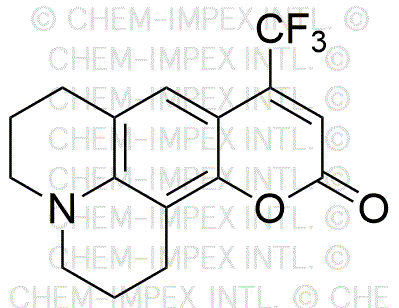Coumarin 153 is widely utilized in research focused on:
- Fluorescent Dyes: This compound is commonly used as a fluorescent dye in biological imaging. Its high quantum yield and stability make it ideal for labeling cells and tissues, allowing researchers to visualize biological processes in real-time.
- Photodynamic Therapy: In the field of medicine, Coumarin 153 is explored for its potential in photodynamic therapy (PDT) for cancer treatment. It can be activated by light to produce reactive oxygen species that selectively destroy cancer cells, offering a targeted treatment option.
- Optical Sensors: This chemical is employed in the development of optical sensors for detecting environmental pollutants. Its sensitivity to changes in the surrounding environment makes it a valuable tool for monitoring air and water quality.
- Laser Technology: Coumarin 153 serves as a laser dye in solid-state and dye lasers. Its ability to emit light at specific wavelengths enhances the performance of lasers used in various applications, including medical and industrial fields.
- Material Science: In material science, it is used to create luminescent materials for organic light-emitting diodes (OLEDs). The incorporation of this compound can improve the efficiency and color purity of OLED devices, making them more effective for display technologies.
General Information
Properties
Safety and Regulations
Applications
Coumarin 153 is widely utilized in research focused on:
- Fluorescent Dyes: This compound is commonly used as a fluorescent dye in biological imaging. Its high quantum yield and stability make it ideal for labeling cells and tissues, allowing researchers to visualize biological processes in real-time.
- Photodynamic Therapy: In the field of medicine, Coumarin 153 is explored for its potential in photodynamic therapy (PDT) for cancer treatment. It can be activated by light to produce reactive oxygen species that selectively destroy cancer cells, offering a targeted treatment option.
- Optical Sensors: This chemical is employed in the development of optical sensors for detecting environmental pollutants. Its sensitivity to changes in the surrounding environment makes it a valuable tool for monitoring air and water quality.
- Laser Technology: Coumarin 153 serves as a laser dye in solid-state and dye lasers. Its ability to emit light at specific wavelengths enhances the performance of lasers used in various applications, including medical and industrial fields.
- Material Science: In material science, it is used to create luminescent materials for organic light-emitting diodes (OLEDs). The incorporation of this compound can improve the efficiency and color purity of OLED devices, making them more effective for display technologies.
Documents
Safety Data Sheets (SDS)
The SDS provides comprehensive safety information on handling, storage, and disposal of the product.
Product Specification (PS)
The PS provides a comprehensive breakdown of the product’s properties, including chemical composition, physical state, purity, and storage requirements. It also details acceptable quality ranges and the product's intended applications.
Certificates of Analysis (COA)
Search for Certificates of Analysis (COA) by entering the products Lot Number. Lot and Batch Numbers can be found on a product’s label following the words ‘Lot’ or ‘Batch’.
*Catalog Number
*Lot Number
Certificates Of Origin (COO)
This COO confirms the country where the product was manufactured, and also details the materials and components used in it and whether it is derived from natural, synthetic, or other specific sources. This certificate may be required for customs, trade, and regulatory compliance.
*Catalog Number
*Lot Number
Safety Data Sheets (SDS)
The SDS provides comprehensive safety information on handling, storage, and disposal of the product.
DownloadProduct Specification (PS)
The PS provides a comprehensive breakdown of the product’s properties, including chemical composition, physical state, purity, and storage requirements. It also details acceptable quality ranges and the product's intended applications.
DownloadCertificates of Analysis (COA)
Search for Certificates of Analysis (COA) by entering the products Lot Number. Lot and Batch Numbers can be found on a product’s label following the words ‘Lot’ or ‘Batch’.
*Catalog Number
*Lot Number
Certificates Of Origin (COO)
This COO confirms the country where the product was manufactured, and also details the materials and components used in it and whether it is derived from natural, synthetic, or other specific sources. This certificate may be required for customs, trade, and regulatory compliance.


